Jean-Baptiste Masson
Further images
-
(View a larger image of thumbnail 1
)
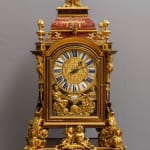
-
(View a larger image of thumbnail 2
)
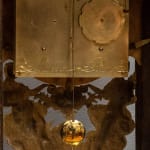
-
(View a larger image of thumbnail 3
)
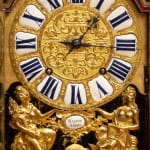
-
(View a larger image of thumbnail 4
)
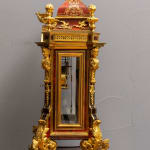
-
(View a larger image of thumbnail 5
)
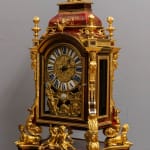
-
(View a larger image of thumbnail 6
)
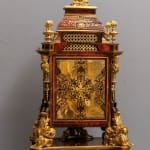
-
(View a larger image of thumbnail 7
)

-
(View a larger image of thumbnail 8
)
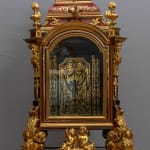
-
(View a larger image of thumbnail 9
)
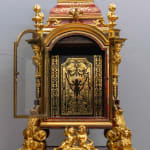
-
(View a larger image of thumbnail 10
)
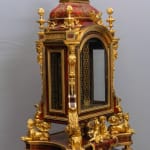
-
(View a larger image of thumbnail 11
)
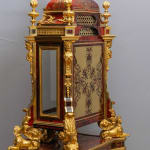
-
(View a larger image of thumbnail 12
)
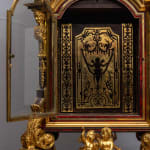
-
(View a larger image of thumbnail 13
)
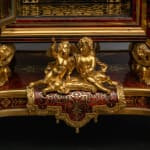
A highly important and extremely fine Louis XIV gilt bronze mounted bracket clock of a month duration by Jean-Baptiste Masson à Paris, signed on an enamel plaque below the dial and again on the backplate of the movement Masson à Paris, housed in a superb tortoiseshell and engraved brass inlaid marquetry case attributed to Charles-André Boulle. The finely lambrequin and foliate scrolled chased dial plate with Roman hour numerals within shaped enamel cartouches and outer minute numerals, with a fine pair of blued steel hands for the hours and minutes. The movement with anchor escapement, silk thread suspension, striking on the full and half hours on a single bell. The superb case finely veneered in Boulle marquetry in brass on grounds of red tortoiseshell and première-partie Boulle work, of architectural rectangular form with an arched cornice surmounted by a gilt bronze globe above gilt bronze borders and four gadrooned urn and foliate finials, above a lambrequin cornice and mounted above the dial arch by a cockerel, the body of the case glazed on three sides, the four canted corners with male herm and scrolled mounts and mounted below the dial by the two female figures of Flora to the left and Urania to the right who seemingly hold up the dial and sit either side of a globe, flanked by a crown and artist’s palette and brushes, the whole raised on scrolled acanthus-wrapped supports, each resting on the back a recumbent sphinx at the corners of a shaped concave-sided base inlaid with tortoiseshell and centred below the dial by a pair of gilt bronze putti who sit on a tassel-hung lambrequin, the frieze, on four turned foliate feet. The door to the movement, inlaid with contre-partie Boulle marquetry and the inside, with contre-partie Boulle marquetry featuring a Bérain style figure in silhouette below a pair of birds and surrounded by arabesques, scrolls and strap-work motifs, the interior floor, below the backplate inlaid with contre-partie Boulle marquetry featuring foliate scrolls within a semi-circle, flanked by radiating diamond motifs
Paris, date circa 1700-10
Height 85 cm, width 50 cm, depth 34 cm.
Literature: Tardy, “La Pendule Française, Ire partie, de l’Horloge Gothique à la Pendule Louis XV”, 1967, p. 98, illustrating a similarly shaped decorated tortoiseshell and brass inlaid marquetry clock in the Musée Saint-Pierre, Lyon, which lacks the sphinxes but has the same relief figures below the dial showing Flora and Urania flanking a globe and an enamel plaque with the maker’s name: Mornand, Faub. Saint Antoine, Paris. Pierre Kjellberg, “Encyclopédie de la Pendule Française du Moyen Age au XXe Siècle”, 1997, p. 45, illustrating an almost identical mantel clock, which the writer describes as important.
Given the quality of craftsmanship, ingenuity of design and the similarity with other clocks made by André-Charles Boulle (1642-1732), this magnificent clock can be safely attributed to the same illustrious maker. André-Charles Boulle, one of the greatest ébénistes to work for Louis XIV, the Sun King. Born in Paris, he came from a family of master craftsmen and artists. His father was Jean Boulle (b. c 1616), ébéniste du Roi who had lodgings in the Louvre, while his grandfather, Pierre Boulle (c. 1595-1649) had been cabinetmaker to Louis XIII and had also lived in the Louvre. Other artistic family members included his maternal aunt Marguerite Bahusche, a noted painter whose husband was the artist Jacques Bunel de Blois and was much admired by Henri IV. André-Charles was thus exposed to two generations of illustrious artists, master craftsmen, engravers and ébénistes. Boulle’s own talent was recognised by Louis XIV’s advisor Jean-Baptiste Colbert, upon whose recommendation Boulle was appointed in 1672 Premier ébéniste du Roi and in this role he furnished many of the royal palaces, notably Versailles. In addition to the French crown and members of the court, Boulle supplied foreign royalty including Philip V of Spain.
Boulle’s name is synonymous with the type of inlaid tortoiseshell and engraved brass marquetry that we see here. Although it was not new, he perfected the technique to produce inlays of the highest quality with unprecedentedly elaborate and inventive designs. In addition to creating pieces of furniture featuring this technique, Boulle created some remarkably fine cases for both longcase and mantel cases, often collaborating with the artist and royal designer Jean Bérain (1640–1711) and the royal sculptor and modeller François Girardon (1628-1715).
Despite his success and the high demand for his work, Boulle was often in financial difficulties, largely due to his passion for old prints and drawings, some of which inspired his own works. Sadly, his art collection, along with much of his stock was destroyed in a fire in 1720. Following the disaster, Boulle continued to work up until 1726, when his business was succeeded by his sons Jean (1680-1744), Pierre (c. 1682-1741), André-Charles (1685-1745) and Charles-Joseph (1688-1754), through whom the tradition of excellence and supreme craftsmanship was passed down to Charles-Joseph Boulle, grandson of André-Charles. Boulle’s influence was extensive and long lasting. Contemporaries throughout Europe imitated his marquetry as did later craftsmen but none were able to match the perfection of original Boulle work.
In addition to the near identical clock illustrated as a full colour page in Pierre Kjellberg’s book on French clocks, there are other clocks with certain similarities to the present. They include a clock and accompanying pedestal in the Metropolitan Museum, New York, which has a movement by Isaac II Thuret, clockmaker to Louis XIV, and case attributed to André-Charles Boulle. Of significance, the clock rests on almost identical recumbent sphinxes and again as here, has four urn-shaped finials below the domed hood. In addition to the clock in the Musée Saint-Pierre, Lyon (cited above in Tardy), the same figures of Flora and Urania appear on other clocks of the period and, may also do so, adorning a Boulle clock that features in Watteau’s famous oil painting L’Enseigne de Gersaint of 1721 (Charlottenburg Palace, Berlin).
While the importance of this clock lies in the beauty and the intricacy of its case, one should not overlook the significance of the master Paris clockmaker Jean-Baptiste Masson, who was the maker of its movement. Masson was the son of the clockmaker Noël Masson and was born at Vaucouleurs-en-Champagne, in north-eastern France, where later Louis XV’s most famous mistress, Jeanne Bécu, Comtesse du Barry, was born in 1743. It was at Vaucouleurs that in 1700 J-B Masson married Geneviève-Renée Delorme by whom they had Charles, who was also to become a clockmaker. Having already worked in Paris, prior to his marriage, in 1700 Masson was received as a Paris maître-horloger and was established at Place Dauphine. He built up a thriving business, counting among his clients the marchand-mercier Lazare Duvaux and also the famous financier and collector Pierre Gruyn, who also owned a clock by Antoine Gaudron, now in the J.P Getty Museum Collection. Masson produced a number of extremely fine clocks that were offset by the beauty of their cases, counting among his suppliers the ébéniste Jean-Michel Ziegler and significantly André-Charles Boulle who almost certainly made the present case.












